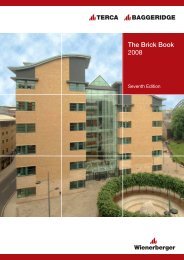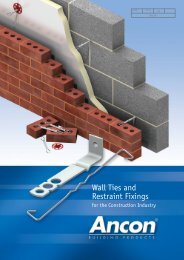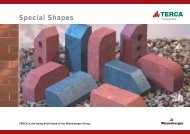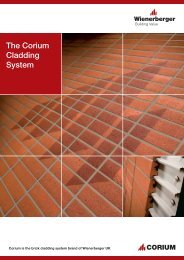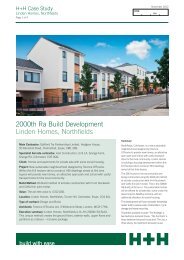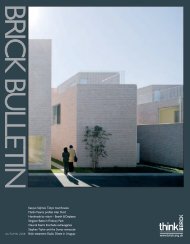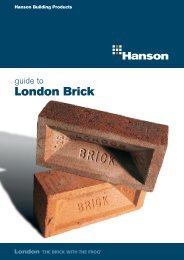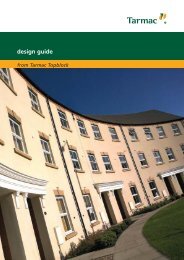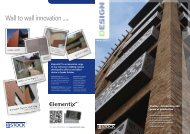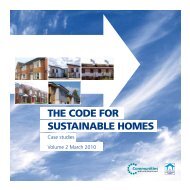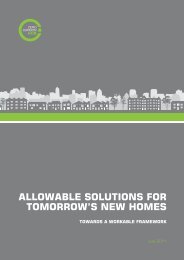Thermal Performance: Part L1A - Masonryfirst.com
Thermal Performance: Part L1A - Masonryfirst.com
Thermal Performance: Part L1A - Masonryfirst.com
You also want an ePaper? Increase the reach of your titles
YUMPU automatically turns print PDFs into web optimized ePapers that Google loves.
<strong>Thermal</strong> <strong>Performance</strong>: <strong>Part</strong> <strong>L1A</strong>General conclusionsAs apparent in Figure 3,the effect of changing the fabricand/or services specification is dependant on dwellingtype, with improvements to the fabric of greatest benefitto dwellings with a large exposed area, particularlydetached houses. Dwellings with a relatively small exposedarea benefit more from the use of low and zero carbontechnologies.Further out<strong>com</strong>es from the study are provided below:Compliance with <strong>Part</strong> L: 2010• Compliance can be achieved without the use ofrenewables, but enhancements to the services may benecessary if fabric specifications 1 or 2 are used. This doesnot have to include MVHR.• Use of fabric specification 3 will, for most dwellingtypes, be adequate to achieve 2010 <strong>com</strong>pliance withoutenhancements to the services.Compliance with <strong>Part</strong> L: 2013• Compliance can be achieved without renewables,providing there is a high standard of fabric performancei.e. somewhere between fabric specification 3 and 4. Inaddition, the services may need upgrading with one ormore of the options featured in the study.• Alternatively, a more relaxed fabric specification can beused in conjunction with a renewable technology suchas PV; although this may be a more expensive route to<strong>com</strong>pliance.Compliance with <strong>Part</strong> L: 2016<strong>Performance</strong> requirements for 2016 are currently underreview and may not be finalised until the end of 2011or early 2012. However, re<strong>com</strong>mendations have beenpresented to the government and will be subject to publicconsultation during 2011. <strong>Performance</strong> will no longer bemeasured in terms of a percentage improvement over<strong>Part</strong> L 2006, instead specific CO 2 targets will be set. There<strong>com</strong>mendations [9] are that the ‘built performance’emissions from new homes should not exceed:• 10 kg CO 2 /m 2 /year for detached houses• 11 kg CO 2 /m 2 /year for other houses• 14 kg CO 2 /m 2 /year for low rise apartment blocks.The Carbon Compliance Standard applies to builtperformance, whereas the 2006 Regulations relateto designed performance. For this reason there<strong>com</strong>mendations cannot be directly <strong>com</strong>pared with the2010/13 performance requirements. However, in additionto any improvement achieved by moving from designedto built performance, the % improvements [9] on the 2006standard would be:• 60% for detached houses• 56% for other houses• 44% for low rise apartment blocks.(This range is represented by the greyed out area on Figure 3).Figure 3 shows that 2016 <strong>com</strong>pliance can be achievedin a variety of ways using fabric specification 3 or fabricspecification 4, in <strong>com</strong>bination with one or more heatrecovery systems and/or PV. The extent to which thesetechnologies are needed depends very much on dwellingtype and level of fabric performance.In some cases, it may just be possible to achieve <strong>com</strong>pliancewithout the use of renewables if a very high standard offabric performance is applied (fabric specification 4 orPassivhaus equivalent) and heat recovery systems are used.However, this is based on the current SAP methodology andassociated assumptions, which may be revised in the run upto 2016.It is likely that for 2016 <strong>com</strong>pliance, the optimal U-valuefor external walls may stop at around 0.15 - 0.18 W/m 2 K,reflecting the cost-benefit limit of insulation as <strong>com</strong>paredto other options for reducing CO 2 emissions. However,whatever the eventual out<strong>com</strong>e is, there is a wide range ofconcrete and masonry options that can meet the highestlevels of fabric performance, and easily exceed the FEESre<strong>com</strong>mendations where required.In addition to meeting the CO 2 targets detailed above,2016 <strong>com</strong>pliance will also require that the minimum fabricperformance requirements specified in the FEES are alsosatisfied. These are currently set at:• 39 kWh/m 2 /year for apartment blocks and mid terracehouses• 46 kWh/m 2 /year for semi detached, end of terrace anddetached houses.All of the dwellings in Figure 3 built to fabric specifications3 and 4 <strong>com</strong>plied with the FEES targets.8



